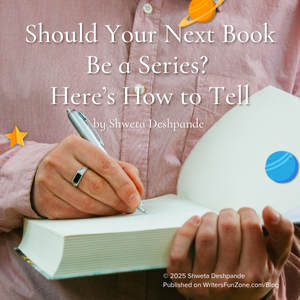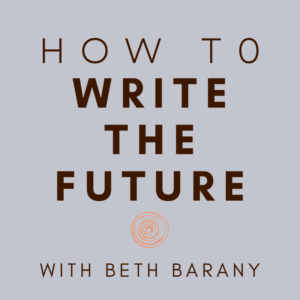Should Your Next Book Be a Series? Here’s How to Tell by Shweta Deshpande
 Today we welcome a new guest writer to Writer’s Fun Zone, who is stopping by to chat with us about “Should Your Next Book Be a Series? Here’s How to Tell.” Enjoy!
Today we welcome a new guest writer to Writer’s Fun Zone, who is stopping by to chat with us about “Should Your Next Book Be a Series? Here’s How to Tell.” Enjoy!
***
You’ve got a story idea brewing, and now you’re staring down one of the biggest choices a writer can make: should you write a standalone novel or dive into a series?
Series dominate bestseller lists, build diehard fanbases, and help you stack up your backlist. (Hello, passive income!)
But there’s no getting around the fact that they also come with more planning, more writing, and more commitment.
So how do you know if your story deserves multiple installments, or if it should wrap up neatly within a single volume?
While there isn’t a one-size-fits-all answer, there are always clues.
Let’s dive into four key signs that your next project has series potential.
1. Your world is bigger than one book
If your story is set in a world with its own history, politics, and culture — a world you’ve poured your heart into building — chances are one book won’t do it justice.
Think A Song of Ice and Fire; George R.R. Martin doesn’t just toss readers into Westeros and hope for the best.
He spends entire pages fleshing out noble houses, ancient lore, and tangled alliances.
You feel the weight of the world in every character decision, from the smallfolk in Flea Bottom to the power players in King’s Landing.
Does your story have multiple regions, cultures, or political systems that interact in intricate ways?
Are there ancient prophecies, secret organizations, or elaborate backstories that are integral to the plot?
If the answer is yes, your narrative probably needs to be a series.
That said, remember: great worldbuilding is never just for the sake of detail.
Every piece of lore should serve your story or reveal something important about your characters.
If it doesn’t drive the plot or deepen your themes, it likely doesn’t need to be there.
2. Your characters have a lot going on
Some stories aren’t just about one character’s journey.
Maybe you’ve got a tangled web of characters, each with their own arc, their own conflicts, and their own evolution.
If you find yourself agonizing over fitting all that character development in a single book, chances are you’ve got a series on your hands.
Consider The Chronicles of Narnia by C.S. Lewis.
Across seven books, the Pevensies (and later, other major characters) each experience their own growth, face unique challenges, and contribute to the overarching story of Narnia.
Trying to compress all of that into a single book would have totally robbed the series of its depth, charm, and sense of adventure.
Can you imagine a series like that as a standalone?
Squash all the books into one, and you’d lose half the magic.
Another great example is the His Dark Materials trilogy by Philip Pullman.
Lyra’s hunt for the truth about Dust barely scratches the surface of this sprawling tale.
Other characters like Will, Iorek, and Serafina (among many others) each go on their own journey.
And that’s before we even get into the big philosophical questions or the epic battles.
So if you’re dedicating entire chapters (or more) just to cover a single character’s backstory or growth, take it as a sign that your story is ready to expand into multiple books.
3. Your plot thrives on cliffhangers
Does your story keep throwing curveballs that lead to bigger questions?
Do you find yourself writing cliffhangers that wouldn’t make sense if they were resolved in the very next chapter?
That’s a strong sign your plot thrives on serial momentum.
If your story is structured around unanswered questions, tangled subplots, or escalating tension, a series is probably the way to go.
Take The Hunger Games — each book introduces new layers of conflict, new settings, and new character challenges, all while maintaining that taut “edge-of-your-seat” suspense.
The first book introduces Katniss, the deadly arena, and key players in her world, setting up a tight, high-stakes survival story.
Catching Fire then expands the scope, throwing political rebellion and deeper character struggles into the mix, while giving supporting characters like Peeta, Gale, and President Snow more room to develop.
By Mockingjay the narrative shifts into full-blown revolution, with personal and political cliffhangers propelling the story forward.
Each installment builds on the last, adding new tensions, fresh settings, and bigger challenges that keep readers hungry for more (no pun intended).
Even romance-heavy series get in on the cliffhanger fun!
In Julia Quinn’s Bridgerton series, each book focuses on a different sibling, yet the family secrets and unresolved drama spill over from one story to the next.
The result is a story that works on its own, while those sly little twists keep readers hooked on the series, eager to see what the next sibling (or scandal) stirs up.
At the same time, it’s important to beware of lazy cliffhangers.
Every book in your series should offer a satisfying mini-conclusion while still teasing what’s to come.
Otherwise, readers might feel strung along without payoff, and nobody wants that.
4. You have a long-term vision
Let’s be real: writing a series isn’t for the faint of heart.
It demands dedication and a solid plan.
Be honest with yourself: do you know where this multi-book ride is headed, or are you just holding on for dear life?
A well-crafted series is like a road trip with a clear destination in mind.
Each stop (or book) should serve a purpose (whether it’s developing characters, introducing new conflicts, or revealing hidden truths), all while driving the overarching narrative arc forward.
A solid hack for avoiding the dreaded “saggy middle” is to break each book into clear story beats before you start writing.
Pinpoint where tension should rise, conflicts should escalate, and key revelations should land.
That’s exactly what J.K. Rowling did with Harry Potter, famously mapping out all seven books before even finishing the first one!
That kind of foresight keeps the momentum sharp and prevents the story from meandering or spiraling into chaos.
Is your book a standalone?
If you’re unsure where your story would go after the first book, a standalone might be the safer bet.
But if you have a clear vision, a series will let you explore your big ideas with depth and freedom, turning that single spark of an idea into a multi-installment adventure.
Ultimately, it comes down to your story’s demands.
If your world, characters, and plot are bursting at the seams, a series could be the perfect playground for your imagination.
But don’t fall for the myth that series are inherently more valuable or commercially successful.
Sometimes less really is more.
A well-executed standalone can make a far bigger impact than a bloated series with little purpose.
At the end of the day, it’s not about how many books you write.
It’s about telling the story only you can tell, in the way it was meant to be told.
***
About The Author
 Shweta Deshpande writes for Reedsy about all things storytelling.
Shweta Deshpande writes for Reedsy about all things storytelling.
Her background spans brand marketing, podcast production, and editorial work.
She holds a Bachelor’s degree in Psychology with a minor in Film Studies, which probably explains her love for horror films and complex character arcs.
When she’s not working, you’ll usually find her tinkering with a creative side project or playing chess badly, yet determinedly.






